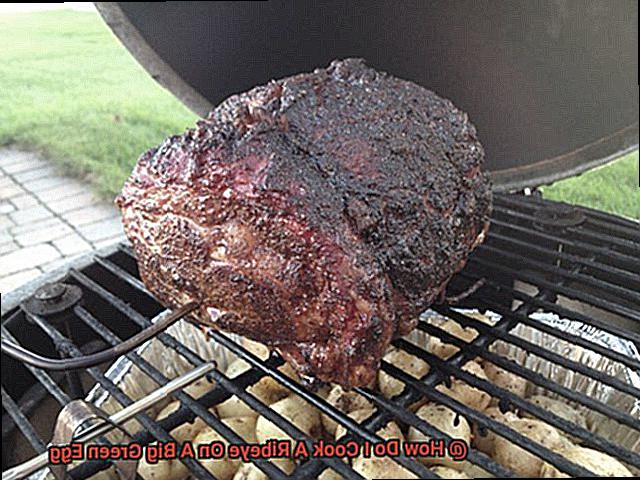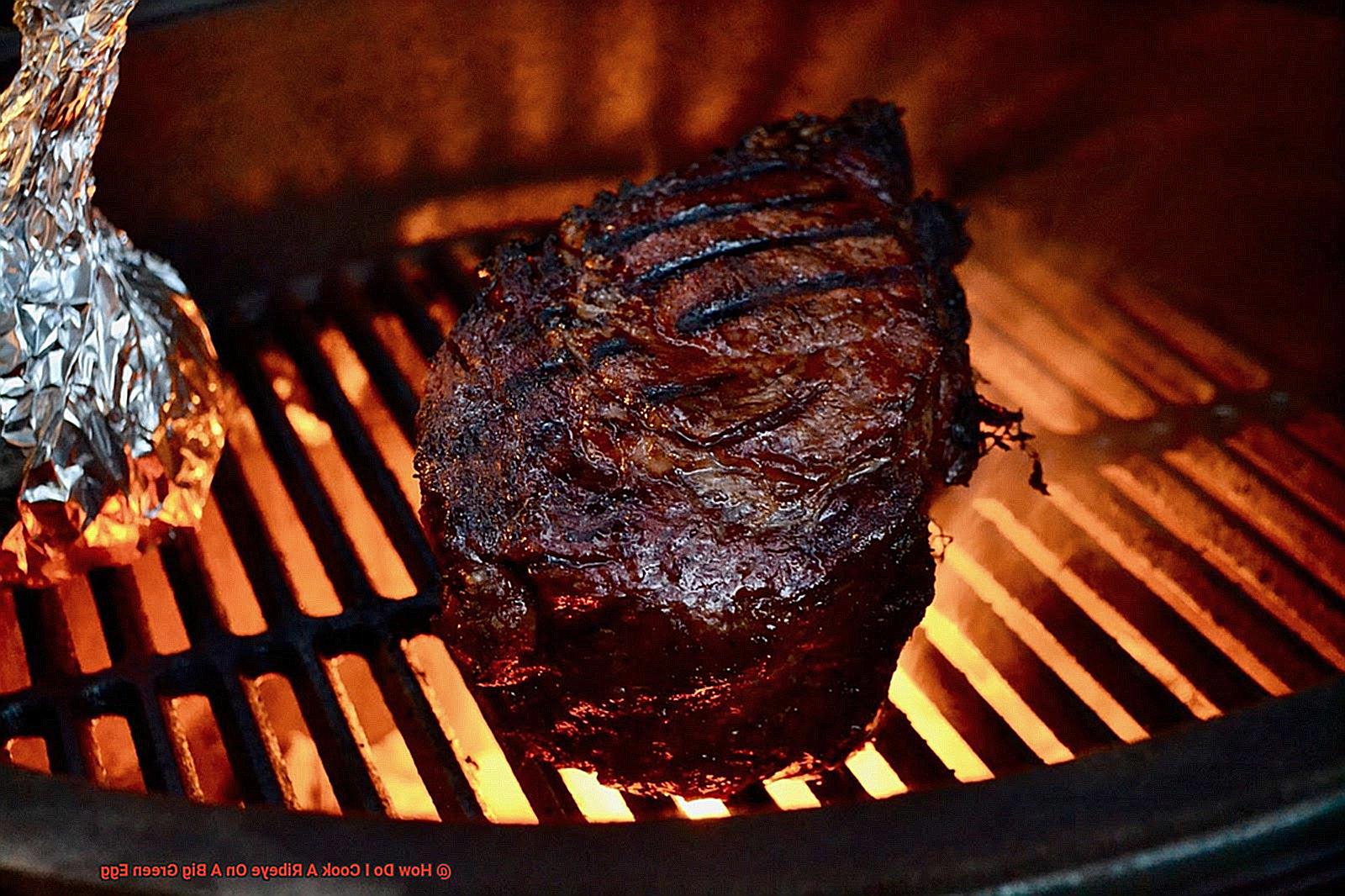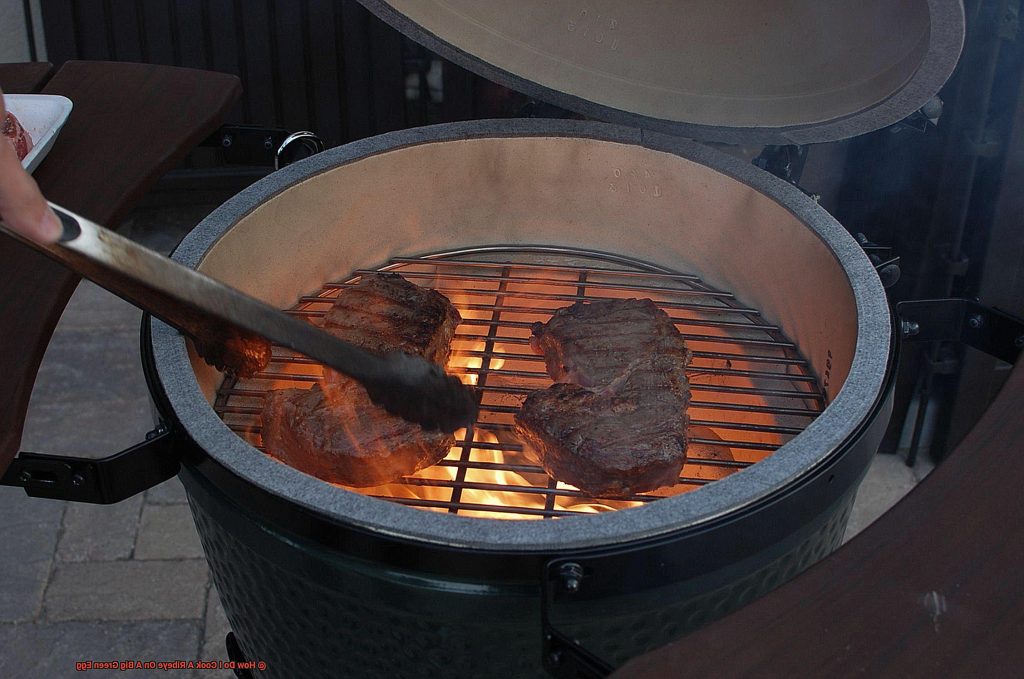Imagine the tantalizing scent of a sizzling ribeye steak, its outer crust perfectly caramelized while the inside remains irresistibly tender. Your taste buds tingle with anticipation as you embark on a culinary adventure in your own backyard. Enter the Big Green EGG, the iconic ceramic grill that ignites every grillmaster’s passion. Today, we delve into the art of cooking a ribeye on this versatile beast.
Achieving steak perfection demands finesse and meticulousness. Begin by gathering your ingredients: a top-notch ribeye steak, preferably USDA Prime or Choice grade, along with kosher salt, freshly ground black pepper, and a hint of olive oil. But here’s the secret ingredient that sets your steak apart – patience. Cooking a ribeye on a Big Green EGG revolves around mastering heat control for an unforgettable feast that earns you the title of grill guru.
In this guide, we unveil the step-by-step process to prepare and grill your ribeye to absolute perfection. Along the way, we’ll share insider tips and tricks to amplify flavor, attain desired doneness levels, and even explore alternative seasoning options for those daring enough to experiment. So don your trusty apron and wield those tongs because it’s time to elevate your grilling prowess and craft a ribeye that leaves even seasoned meat connoisseurs in awe. Brace yourself for family and friends hailing you as their ultimate grill champion.
Contents
Preheat the Big Green EGG – How to get the best sear on your steak
Grilling a ribeye steak to perfection requires more than just skillful cooking techniques – it starts with properly preheating your Big Green EGG. This step is crucial to achieving that mouthwatering sear and locking in all the juicy flavors. In this guide, we’ll take you through the essential steps to preheat your Big Green EGG for the best sear on your ribeye steak. So grab your apron and let’s fire up that grill.
Step 1: Clean the Big Green EGG
Before you start preheating, ensure that your Big Green EGG is clean and free of any debris or leftover residue from previous grilling sessions. Use a grill brush to scrape away any stuck-on food particles from the grates, and make sure the vents are clear of any obstructions.
Step 2: Gather your materials
You’ll need charcoal, a natural fire starter or electric starter, and a digital thermometer or built-in thermometer for temperature control. Avoid using lighter fluid as it can leave a chemical taste on your steak.
Step 3: Ignite the charcoal
Add an even layer of charcoal to the firebox of your Big Green EGG, following the manufacturer’s guidelines for the desired cooking temperature. Place a natural fire starter or position an electric starter in different spots to ensure even ignition. Allow the charcoal to burn until it is covered with a thin layer of ash, indicating it’s ready for cooking.
Step 4: Adjust airflow for desired temperature
To achieve that perfect sear, you’ll want to preheat your Big Green EGG to a temperature between 500-600°F (260-315°C). Adjust the vents to control airflow – higher airflow will result in a hotter grill, while reducing airflow will lower the temperature.
Step 5: Measure the temperature
To accurately measure the temperature, place a digital thermometer probe near the grates, close to where you’ll be cooking your steak. Let the grill preheat for about 10-15 minutes, giving it enough time to reach the desired temperature.
Step 6: Prepare your ribeye steak
While the Big Green EGG is preheating, take the opportunity to season your ribeye generously with salt, pepper, or any other desired seasonings. Let it sit at room temperature for about 30 minutes for even cooking.
Step 7: Sear your ribeye steak
Once the Big Green EGG has reached the desired temperature, it’s time to sear your ribeye steak. Open the lid and place the steak directly on the hot grates. Depending on the thickness of your steak and desired level of doneness, sear each side for about 2-3 minutes per side.
Preparing the Ribeye – Seasoning tips for maximum flavor
Get ready to elevate your ribeye game to the next level with these mouthwatering seasoning tips and techniques. Prepare to have your taste buds dancing with delight when you fire up your Big Green EGG. Let’s dive right in and uncover the secrets to maximum flavor.
- Start with the best: Look for a well-marbled ribeye steak. The marbling adds richness, juiciness, and intense flavor, so don’t be shy.
- Embrace room temperature magic: Allow the steak to come to room temperature before seasoning. This ensures even cooking and brings out the best flavors.
- Keep it simple yet bold: Begin with a generous sprinkle of sea salt and freshly ground black pepper to let the natural beefy goodness shine through. Feeling adventurous? Add a pinch of garlic powder, onion powder, paprika, dried herbs like rosemary or thyme, or a touch of cayenne pepper for some heat.
- Let it mingle and intensify: After seasoning, let the ribeye sit for at least 30 minutes. This allows the flavors to penetrate the meat and creates a more flavorful experience.
- Marinate for extra oomph: Take it up a notch by marinating your ribeye in a tantalizing combination of soy sauce, Worcestershire sauce, garlic, and herbs. Let it marinade in the fridge for a few hours or overnight for an explosion of flavor.
- Preheat like a pro: Before grilling, ensure your Big Green EGG is preheated to perfection. High heat is key for that perfect sear while keeping the inside tender and juicy.
- Cook to perfection: Grill your ribeye for about 4-5 minutes per side for medium-rare, but adjust according to your desired level of doneness.

Cook the Ribeye Directly on the Grates – The importance of monitoring internal temperature
But there’s a secret ingredient that will truly elevate your steak game – monitoring the internal temperature. Trust me, it’s not as complicated as it sounds, and I’m here to break it down for you.
First things first, why is monitoring the internal temperature so important? Well, think of it as your secret weapon to achieving the perfect doneness every single time. Whether you like your ribeye rare, medium-rare, or well-done, the internal temperature is your guide to ensuring that each bite is exactly how you want it.
So, how do you keep tabs on this magical number? It’s simple – invest in a reliable meat thermometer. This nifty tool will allow you to accurately measure the internal temperature of your ribeye without having to cut into it and risk losing all those precious juices. Trust me, you won’t regret having this gadget in your grilling arsenal.
Now that you have your trusty thermometer, let’s talk about the step-by-step process. Preheat your Big Green EGG to a high temperature to get that beautiful sear on the outside of the ribeye. This initial sear creates a caramelized crust that adds depth of flavor and locks in all those delicious juices.
Once you’ve achieved that gorgeous crust, reduce the heat to a medium level and continue cooking until your meat reaches the desired internal temperature. This gradual cooking process ensures that your ribeye cooks evenly from edge to center, resulting in a juicy and tender steak that will make your taste buds sing.
But here’s a little tip – remove the ribeye from the grill when its internal temperature is a few degrees below your desired doneness. Why? Because of carryover cooking. As the ribeye rests, residual heat will continue to cook the meat, bringing it to perfection without overcooking. It’s like magic.
And speaking of resting, don’t skip this crucial step. Allow your ribeye to rest for a few minutes after cooking. This gives the juices inside the meat a chance to redistribute, resulting in a more tender and flavorful steak. Covering the ribeye loosely with foil during this resting period helps retain heat and moisture, ensuring that each bite is as juicy as can be.
Moving to a Cooler Part of the Grill – How to achieve a more well-done steak
Grilling a steak to perfection is an art form, and achieving the ideal level of doneness can be a challenge. Some like it rare, others prefer medium-rare, but if you’re a well-done steak lover, you may find that your ribeye is cooked perfectly on the outside but still pink in the center. Don’t worry, though – there’s a technique that can help you achieve a more well-done steak on your Big Green EGG: moving it to a cooler part of the grill.
The Big Green EGG is renowned for its exceptional heat retention and even distribution, making it perfect for grilling steaks. However, when it comes to well-done steaks, the high heat can sometimes result in an overcooked exterior and an undercooked interior. That’s where moving the steak to a cooler part of the grill comes in.
To start, preheat your Big Green EGG to a blazing 500°F (260°C). This initial high heat will give your ribeye a fantastic sear and those coveted grill marks. Once the grill is hot and ready, place your seasoned ribeye directly over the hottest part of the grill grates and let it sear for about 2-3 minutes per side.
Once you’ve achieved that beautiful sear on both sides, it’s time to move the ribeye to a cooler part of the grill. You can do this by either reducing the heat on your Big Green EGG or creating different temperature zones within the grill. To create different temperature zones, simply move the ribeye away from direct heat by placing it on a cooler part of the grill grates or utilizing indirect cooking methods such as using a plate setter or adding a deflector.
By moving the ribeye to a cooler part of the grill, you allow it to cook more slowly and evenly, ensuring that the center reaches the desired level of doneness. Remember that a well-done steak will require additional cooking time, so be prepared to adjust accordingly. Use a meat thermometer to monitor the internal temperature of the ribeye. For a well-done steak, aim for an internal temperature of 160°F (71°C).
During this stage, resist the urge to rush the cooking process by turning up the heat or increasing cooking time drastically. Doing so may result in an overcooked exterior and a dry, tough interior. Patience is key when it comes to cooking a well-done steak, as it requires finding that delicate balance between achieving the desired doneness and maintaining moisture and tenderness.
While the ribeye is cooking on the cooler part of the grill, take the opportunity to baste it with your favorite marinade or brush it with melted butter infused with herbs and garlic. This not only enhances the flavor but also adds a beautiful glaze to the steak.
Flipping and Rotating the Steak – Techniques for achieving crosshatch grill marks
Grilling the perfect steak is an art that requires skill, precision, and a touch of creativity. One technique that can take your ribeye to the next level is achieving those coveted crosshatch grill marks. Not only do they make your steak look like a work of art, but they also enhance the flavor and ensure even cooking. In this guide, we’ll walk you through the techniques for flipping and rotating your steak on a Big Green EGG to achieve those beautiful crosshatch grill marks.
Step 1: Preparing for Grilling
Before you start grilling, preheat your Big Green EGG to the desired temperature, around 400-450°F for a perfectly cooked ribeye. This ensures even cooking and a delicious crust. Generously season your ribeye with salt, pepper, or your favorite seasoning blend to enhance its flavor.
Step 2: Initial Placement
Place the ribeye diagonally across the grill grates at a 45-degree angle. This sets the foundation for achieving those beautiful crosshatch grill marks. Close the lid and let the steak cook for 2-3 minutes.
Step 3: First Flip and Rotation
Carefully lift and turn the ribeye 90 degrees clockwise using tongs or a spatula. This creates the first set of diagonal grill marks on one side of the steak. Close the lid again and let it cook for another 2-3 minutes.
Step 4: Flipping and Second Rotation
Flip the ribeye over and position it diagonally in the opposite direction at a 45-degree angle from its previous placement. This rotation ensures a beautiful crosshatch pattern when you finish grilling. Close the lid and let it cook for another 2-3 minutes.
Step 5: Checking for Doneness
Check the internal temperature of the steak using an instant-read meat thermometer. Aim for around 130-135°F for a medium-rare steak. This step ensures your steak is cooked to perfection.
Step 6: Resting and Enjoying
Remove the ribeye from the grill and let it rest for a few minutes before slicing into it. This allows the juices to redistribute within the meat, ensuring a tender and flavorful bite.
Resting Period and Slicing Against the Grain – Maximizing tenderness and juiciness
You’ve just grilled the perfect ribeye steak on your Big Green EGG. The tantalizing aroma fills the air as you anticipate sinking your teeth into a tender, juicy piece of meat. But wait. Before you slice into that masterpiece, there are two crucial steps you need to take to maximize its tenderness and juiciness: resting and slicing against the grain.
Resting is like a mini-vacation for your steak. After cooking, it’s important to let it rest for about 5-10 minutes. Why? Well, during the cooking process, heat causes the juices to move towards the center of the steak. Resting allows those precious juices to redistribute throughout the meat, resulting in a more tender and juicier final product. It’s like giving your steak time to relax and regroup before its grand entrance onto your plate.
Now that your ribeye has had its well-deserved rest, it’s time to get slicing. But not just any kind of slicing – we’re talking about slicing against the grain. “What does that mean?” you may ask. Well, let’s break it down.
The “grain” refers to the direction of the muscle fibers in the meat. By identifying these fibers and cutting perpendicular to them, you’re essentially shortening them, making each bite more tender and easier to chew. It’s like taking a shortcut through a maze of toughness and arriving at a succulent destination.
To determine the direction of the grain, look for long lines or striations running across the surface of the steak. These lines indicate the direction of the muscle fibers. Now, armed with a sharp knife, cut across these lines, perpendicular to the grain. This technique helps break up tough connective tissues and results in a more tender and enjoyable eating experience.
By allowing your ribeye to rest and slicing against the grain, you’ll be able to fully appreciate the quality of the meat. Resting helps retain moisture within the steak, preventing excessive drying out when sliced. Slicing against the grain shortens muscle fibers, reducing their toughness and making each bite a tender delight.

Finishing Touches – Optional butter brushing or steak sauce drizzles
In this blog post, we’ll explore two options: butter brushing and steak sauce drizzles. These optional additions can enhance the flavor profile of your ribeye, adding richness, tenderness, and complexity. So, let’s dive in.
Butter Brushing:
Butter brushing is a fantastic way to elevate your ribeye steak. The melted butter brings a rich and luscious flavor to the meat, enhancing its juiciness and tenderness. To achieve this indulgent touch, melt a generous knob of butter over low heat until it becomes a golden liquid. With a basting brush in hand, apply the melted butter generously to both sides of the ribeye, ensuring every inch is coated in this decadent goodness. As the steak rests, the gentle heat will cause the butter to melt further and infuse into the meat, creating a mouthwatering experience with every bite.
Steak Sauce Drizzles:
Some may argue that a perfectly cooked ribeye doesn’t need any additional sauces, but others enjoy the added complexity and tang that a good steak sauce can provide. There are plenty of options available in the market, from classic choices like A1 and HP sauce to more gourmet selections like chimichurri or bordelaise. Experiment with different sauces to find your perfect pairing with a juicy ribeye.
Pouring Method:
One approach is to pour a small amount of steak sauce over the top of the cooked ribeye just before serving. This allows the flavors to mingle without overpowering the natural taste of the meat. The sauce will gently cascade down the sides of the ribeye, infusing each slice with its distinctive essence.
Dipping Sauce:
Alternatively, serve the steak sauce on the side as a dipping sauce, allowing each person to customize their desired amount. This way, everyone can enjoy the ribeye with their preferred level of sauce. The dipping method lets the ribeye be the star of the show while offering a delightful enhancement with every dip.
w6LMINVaxqw” >
Conclusion
In conclusion, cooking a ribeye on a Big Green EGG is an art that requires skill and precision. The sizzling sound of the meat hitting the hot grates, the mouthwatering aroma that fills the air, and the anticipation of that first juicy bite – it’s an experience like no other.
To achieve the perfect ribeye on your Big Green EGG, start by selecting a high-quality cut of meat. Look for marbling throughout the steak, as this will ensure tenderness and flavor. Let the steak come to room temperature before grilling to promote even cooking.
Preheat your Big Green EGG to a temperature of around 500°F (260°C). This high heat will sear the exterior of the steak, creating a delicious crust while locking in its natural juices. Place the ribeye directly on the grill grates and let it cook for about 4-5 minutes per side for medium-rare doneness.
During cooking, resist the temptation to constantly flip or poke at the steak. Allow it to develop those beautiful grill marks and charred edges. Use tongs instead of a fork to avoid piercing the meat and losing precious juices.
Once cooked to your desired doneness, remove the ribeye from the grill and let it rest for a few minutes. This resting period allows the juices to redistribute within the meat, resulting in a tender and juicy steak.
Finally, slice into your perfectly cooked ribeye and savor each bite. The rich flavor, melt-in-your-mouth texture, and smoky undertones will make you feel like a true culinary master.
So fire up your Big Green EGG, grab a ribeye steak, and get ready to impress your friends and family with your grilling skills. With practice and attention to detail, you’ll be able to cook a ribeye on your Big Green EGG that rivals any steakhouse experience.






